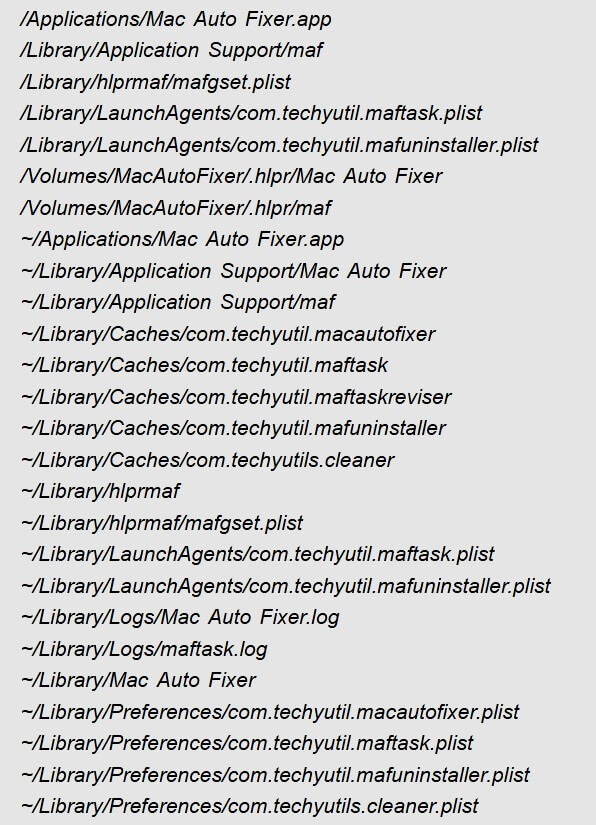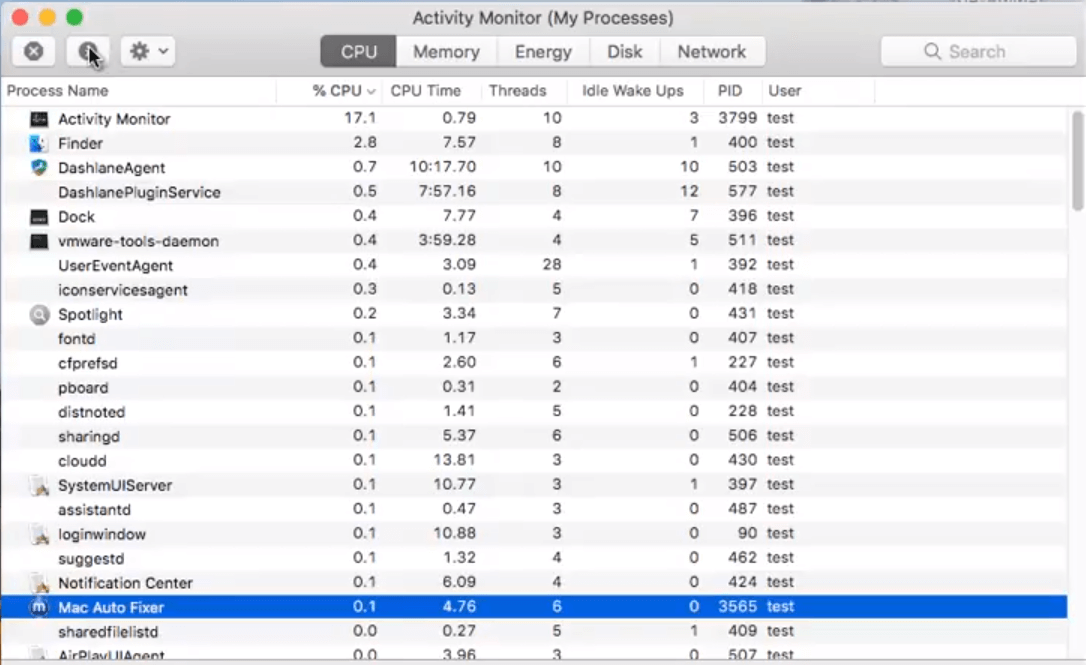What is Maftask Process and what is it doing to your Mac?
Maftask is a suspicious process associated with the potentially unwanted program MacAutoFixer. In this article, you will find more details on its impact as well as removal steps. Once the associated program is loaded on your machine, you may continuously see it appear in the Activity Monitor. Even though Mac Auto Fixer is advertised as a legitimate cleanup utility, it is rogue software that primarily aims to scam you to buy its full version.


Threat Summary
| Name | Maftask |
| Type | Suspicious PUP |
| Short Description | An undesired process activated by Mac Auto Fixer. |
| Symptoms | It loads on each system start and appears in Activity Monitor. |
| Distribution Method | Software bundling; Corrupted freeware installers |
| Detection Tool |
See If Your System Has Been Affected by malware
Combo Cleaner
Malware Removal Tool
|
User Experience | Join Our Forum to Discuss Maftask. |
Maftask – How Did I Get It Along With Its Associated Files Installed?
The suspicious process could be running on Mac devices affected by the potentially unwanted program associated with it. Since this is not considered malicious, its presence on the device could lead to annoying issues such as an increased number of online ads, unexpected browser redirects, aggressive pop-ups, etc. but not files corruption or data theft.
It could access your device via shady spread techniques like software bundling, third-party installers, malvertising, spam emails, and fake notifications. All these techniques aim to trick you into installing the app without noticing its presence.
The main distribution channel is likely to be third-party apps with compromised installers. Since many supposedly useful apps are based on open source code, many could be easily modified by malware actors to deliver harmful code efficiently. Modifications usually are applied to the installers of target free third-party apps. So once released across the web, compromised versions of freeware could be set to install additional hidden apps.
Happily, there is a way to prevent undesired apps like the one associated with Maftask from invading your device by selecting the Advanced/Custom configuration option presented in the installers of newly downloaded apps. Once you open this step, you may find out that the installer contains extras that are to be installed along with the primary app and eventually opt out of their installation.
What is Maftask? More Information and Know-How
The rogue app Max Auto Fixer starts this suspicious process. It could be set to load on each system start, which in turn automatically activates the program. Even though Mac Auto Fixer is advertised as a legitimate cleanup utility, it just another PUP that targets Macs. As identified by security experts, rogue software primarily aims to scam you to buy its full version.
For the purpose, it performs an automated scan that almost always ends up with the display of several detected system errors that interfere with your computer’s performance. However, these errors are not real, and their sole purpose is to trick you into purchasing the full version of this rogue app.
According to reports made by affected users, Mac Auto Fixer is a really persistent program that could still find a way to run on the device even after it is closed or moved to the Trash. This could be explained by the fact that some applications are configured to create their files in more than one folder, which prevents their straightforward removal.
Dragging the undesired Max Auto Fixer to the Trash may not result in its complete deletion. You cannot empty the Trash and after restarting, it could still appear in your Application Monitor, as shown below:
If you want to prevent unwanted processes from starting on every system start, you should remove all files and objects associated with the Mac Auto Fixer PUP. For the purpose, you could follow the step-by-step guide below. During the removal, make sure to check your Library folder as it is believed to contain several files associated with the PUP.
Mac Auto Fixer associated files are usually bundled in the installers of freeware, downloaded from the web. Users that have downloaded it or were affected unintentionally could be experiencing intrusive fake virus alerts and pop-up messages with warnings about viruses.
Remove Maftask Virus Manually or Uninstall It Automatically for Mac

To remove the undesired process Maftask from your affected machine, you should find and delete all files installed by the Mac Auto Fixer program. Most of those are listed on the picture on the right of this text, but there could be more files specific to your system.
For the purpose, you could use the steps listed in the removal below. It presents both manual and automatic removal approaches that combined will help you to get rid of it completely.
The automated approach guarantees maximum efficiency as a scan with an advanced anti-malware tool reveals the exact location of all harmful files and objects created by the PUP.
In case you have further questions or need additional help, don’t hesitate to leave a comment or contact us via email.
Steps to Prepare Before Removal:
Before starting to follow the steps below, be advised that you should first do the following preparations:
- Backup your files in case the worst happens.
- Make sure to have a device with these instructions on standy.
- Arm yourself with patience.
- 1. Scan for Mac Malware
- 2. Uninstall Risky Apps
- 3. Clean Your Browsers
Step 1: Scan for and remove Maftask files from your Mac
When you are facing problems on your Mac as a result of unwanted scripts and programs such as Maftask, the recommended way of eliminating the threat is by using an anti-malware program. SpyHunter for Mac offers advanced security features along with other modules that will improve your Mac’s security and protect it in the future.

Quick and Easy Mac Malware Video Removal Guide
Bonus Step: How to Make Your Mac Run Faster?
Mac machines maintain probably the fastest operating system out there. Still, Macs do become slow and sluggish sometimes. The video guide below examines all of the possible problems that may lead to your Mac being slower than usual as well as all of the steps that can help you to speed up your Mac.
Step 2: Uninstall Maftask and remove related files and objects
1. Hit the ⇧+⌘+U keys to open Utilities. Another way is to click on “Go” and then click “Utilities”, like the image below shows:

2. Find Activity Monitor and double-click it:

3. In the Activity Monitor look for any suspicious processes, belonging or related to Maftask:


4. Click on the "Go" button again, but this time select Applications. Another way is with the ⇧+⌘+A buttons.
5. In the Applications menu, look for any suspicious app or an app with a name, similar or identical to Maftask. If you find it, right-click on the app and select “Move to Trash”.

6. Select Accounts, after which click on the Login Items preference. Your Mac will then show you a list of items that start automatically when you log in. Look for any suspicious apps identical or similar to Maftask. Check the app you want to stop from running automatically and then select on the Minus (“-“) icon to hide it.
7. Remove any leftover files that might be related to this threat manually by following the sub-steps below:
- Go to Finder.
- In the search bar type the name of the app that you want to remove.
- Above the search bar change the two drop down menus to “System Files” and “Are Included” so that you can see all of the files associated with the application you want to remove. Bear in mind that some of the files may not be related to the app so be very careful which files you delete.
- If all of the files are related, hold the ⌘+A buttons to select them and then drive them to “Trash”.
In case you cannot remove Maftask via Step 1 above:
In case you cannot find the virus files and objects in your Applications or other places we have shown above, you can manually look for them in the Libraries of your Mac. But before doing this, please read the disclaimer below:
1. Click on "Go" and Then "Go to Folder" as shown underneath:

2. Type in "/Library/LauchAgents/" and click Ok:

3. Delete all of the virus files that have similar or the same name as Maftask. If you believe there is no such file, do not delete anything.

You can repeat the same procedure with the following other Library directories:
→ ~/Library/LaunchAgents
/Library/LaunchDaemons
Tip: ~ is there on purpose, because it leads to more LaunchAgents.
Step 3: Remove Maftask – related extensions from Safari / Chrome / Firefox









Maftask-FAQ
What is Maftask on your Mac?
The Maftask threat is probably a potentially unwanted app. There is also a chance it could be related to Mac malware. If so, such apps tend to slow your Mac down significantly and display advertisements. They could also use cookies and other trackers to obtain browsing information from the installed web browsers on your Mac.
Can Macs Get Viruses?
Yes. As much as any other device, Apple computers do get malware. Apple devices may not be a frequent target by malware authors, but rest assured that almost all of the Apple devices can become infected with a threat.
What Types of Mac Threats Are There?
According to most malware researchers and cyber-security experts, the types of threats that can currently infect your Mac can be rogue antivirus programs, adware or hijackers (PUPs), Trojan horses, ransomware and crypto-miner malware.
What To Do If I Have a Mac Virus, Like Maftask?
Do not panic! You can easily get rid of most Mac threats by firstly isolating them and then removing them. One recommended way to do that is by using a reputable malware removal software that can take care of the removal automatically for you.
There are many Mac anti-malware apps out there that you can choose from. SpyHunter for Mac is one of the reccomended Mac anti-malware apps, that can scan for free and detect any viruses. This saves time for manual removal that you would otherwise have to do.
How to Secure My Data from Maftask?
With few simple actions. First and foremost, it is imperative that you follow these steps:
Step 1: Find a safe computer and connect it to another network, not the one that your Mac was infected in.
Step 2: Change all of your passwords, starting from your e-mail passwords.
Step 3: Enable two-factor authentication for protection of your important accounts.
Step 4: Call your bank to change your credit card details (secret code, etc.) if you have saved your credit card for online shopping or have done online activiites with your card.
Step 5: Make sure to call your ISP (Internet provider or carrier) and ask them to change your IP address.
Step 6: Change your Wi-Fi password.
Step 7: (Optional): Make sure to scan all of the devices connected to your network for viruses and repeat these steps for them if they are affected.
Step 8: Install anti-malware software with real-time protection on every device you have.
Step 9: Try not to download software from sites you know nothing about and stay away from low-reputation websites in general.
If you follow these reccomendations, your network and Apple devices will become significantly more safe against any threats or information invasive software and be virus free and protected in the future too.
More tips you can find on our MacOS Virus section, where you can also ask any questions and comment about your Mac problems.
About the Maftask Research
The content we publish on SensorsTechForum.com, this Maftask how-to removal guide included, is the outcome of extensive research, hard work and our team’s devotion to help you remove the specific macOS issue.
How did we conduct the research on Maftask?
Please note that our research is based on an independent investigation. We are in contact with independent security researchers, thanks to which we receive daily updates on the latest malware definitions, including the various types of Mac threats, especially adware and potentially unwanted apps (PUAs).
Furthermore, the research behind the Maftask threat is backed with VirusTotal.
To better understand the threat posed by Mac malware, please refer to the following articles which provide knowledgeable details.



